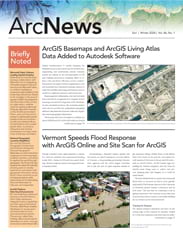Organizations of all types need to leverage geospatial data in ways that improve operations, support collaboration, and boost business outcomes. Being able to quickly implement solutions that make data more accessible to stakeholders across an organization is key to making this happen. But that’s not always easy.
Consider the GIS department at a government agency. The department receives frequent requests to assemble geospatial content in support of specific tasks, projects, or missions, such as transportation and land development or disaster response. This content needs to be used by agency staff members, external stakeholders, and sometimes the public—none of whom typically have time to deal with a steep learning curve. The GIS team collates data from different departments and, at times, several industry partners, meaning that the data is stored in multiple locations and can be difficult to gather, parse, and share.
Using Atlas, a new app template in ArcGIS Instant Apps, GIS analysts can instead—within minutes—create lightweight, interactive web apps that enable stakeholders to explore collections of carefully curated geospatial content. The app essentially allows GIS analysts to create a digital atlas that’s easy to explore, presents layers of context that enable users to conduct simple analyses, and allows for easy sharing.
There are several advantages to using Atlas to build simple apps of curated content, including the following:
It’s Easy to Assemble a Relevant Data Collection
When GIS analysts first receive a request, they need to determine what data is relevant to the request and where to locate it. Oftentimes, relevant data is stored privately on someone’s computer, shared with a specific group in an organization, or saved within another organization’s system.
Once GIS analysts locate the data they need and load it into ArcGIS Online, they must organize it in a way that end users can access it. A common practice is to create a group in ArcGIS Online, where GIS analysts gather curated content and grant access to stakeholders (from both inside and outside the organization) by making them members of the group. GIS analysts can also enable group members to retrieve and see other organizations’ content by establishing a partnered collaboration between ArcGIS Online organizations.
From within the group, GIS analysts can then use the Atlas template in ArcGIS Instant Apps to create an interactive app that serves as a digital atlas for users to explore maps and data. All the maps and layers that were added to the group automatically populate the Atlas app, putting them in one place where group members can access them. (Alternatively, GIS analysts who don’t create a group in ArcGIS Online in advance can manually pick and choose what content to add to the app as they’re configuring it.)
Atlas automatically pulls each item’s title, thumbnail image, and description and organizes the content into predefined categories that are relevant to the group. This enables users of the Atlas-built app to easily browse the maps and layers or search for specific content using keywords.
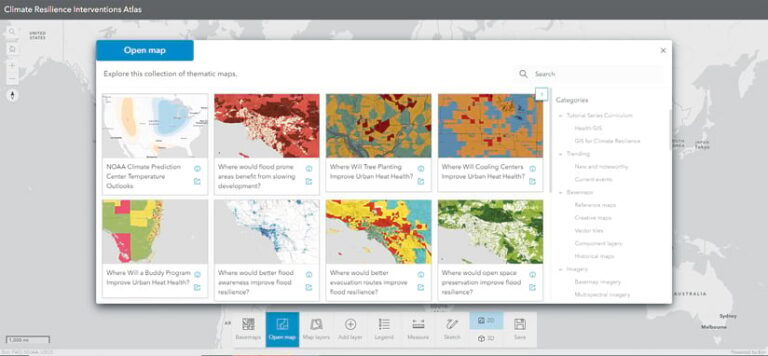
To create a good user experience, GIS analysts should think about what content is most relevant to the app’s audience and double-check that maps and layers have easy-to-read pop-ups and sufficient metadata. They should also organize the content into categories that are pertinent to group members and create bookmarks that users can employ to focus the map on certain areas of interest.
It Provides an Intuitive Map Exploration Experience
Since the users of an app may have little or no GIS experience, GIS analysts need to ensure that all members of their audience can effectively explore and interact with the data and discover the information they need without guidance.
Atlas enables GIS analysts to efficiently create a simple app that lets users open various maps from a gallery and interact with different areas on a map by searching for a location or zooming to a spatial bookmark, opening the legend and pop-ups, using a swipe tool, and measuring distance and area. Users can also choose other basemaps and add or remove map layers to gain additional insight. The Atlas app-building template includes a large toolbar menu on the bottom that allows GIS analysts to add or remove tools to best suit the group for which they’re building the app.
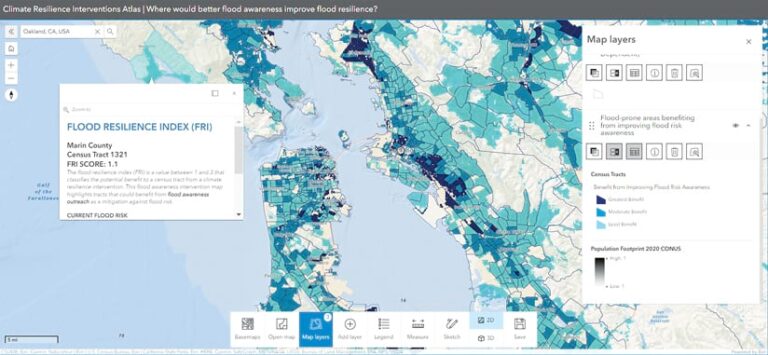
For example, to provide additional perspectives on the same dataset, GIS analysts can add a tool to their app that lets users change the view of the map from 2D to 3D. With this, users can explore the terrain, observe shade and wind shields by panning the map, open a weather simulation, and calculate an area’s elevation profile.
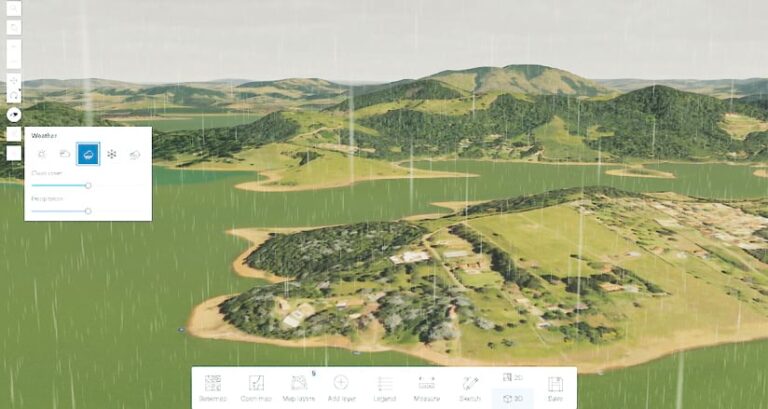
It Allows Stakeholders to Save and Share Their Work
In many instances, stakeholders need an easy way to share the geospatial work they’ve done so that they can effectively collaborate with others. After a hurricane, for example, a city government GIS department may be asked to coordinate with federal agencies to get aid, insurance companies to report damaged areas, emergency medical teams to coordinate rescues, and the media to keep the public updated.
Apps made using the Atlas template allow users to employ sketch tools to make notes and mark locations on a map. After users explore the map, glean insight from the data, and add notes and markups, they can save their work as a new map in ArcGIS Online and create an entirely new app with it, such as an ArcGIS StoryMaps story. They can also share their work with other stakeholders by taking a screenshot of the map, complete with a legend and pop-ups, or exporting it as a PDF.
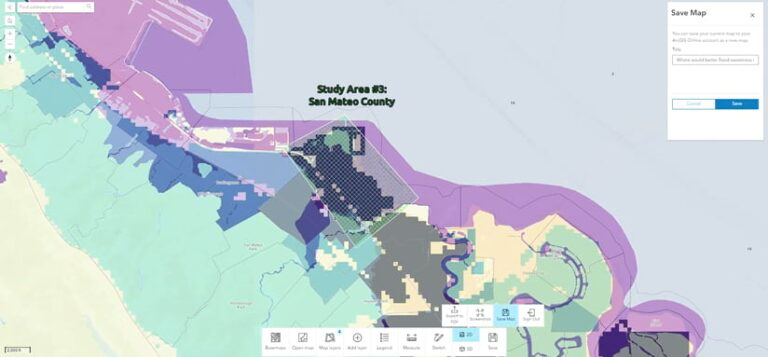
GIS Analysts Can Quickly Meet Deadlines and Organizational Requirements
Even when GIS analysts need to create solutions on a short timeline, those solutions often must meet their organizations’ requirements for accessibility, mobile responsiveness, and even branding.
Instant Apps—including Atlas—is designed to help GIS analysts and other app creators build focused, interactive web apps from their maps in minutes. Using the default express setup options, GIS analysts can publish their apps quickly by only including the essential settings in Atlas, such as a preset theme and simple map tools like search and zoom control. For apps that require additional customization, they can use the full configuration of Atlas to explore and add other map tools and change the app’s appearance by, for example, including a cover page, inserting a customized app title, and incorporating a logo.
Make Use of a Variety of Purpose-Driven App Templates
Instant Apps has nearly two dozen purpose-driven app templates that enable GIS analysts to quickly build apps that can display an organization’s collection of content (Atlas, Portfolio, and Category Gallery); showcase 2D, 3D, and temporal data in a map (Sidebar, Insets, Exhibit, 3D Viewer, Slider, and others); and deliver local information based on proximity to a certain location (Nearby, Zone Lookup, and Public Notification). The resultant apps let users interact with different capabilities and features in a map, including attachments, charts, and bookmarks.
The apps perform well on desktop computers and mobile devices, support accessibility, and include theming tools that help GIS analysts customize the look and style of their apps to conform to their organizations’ branding requirements.
Instant Apps is part of the essential apps bundle in ArcGIS Online and ArcGIS Enterprise, and using it requires no additional licensing.
Learn more about ArcGIS Instant Apps and the Atlas template.

